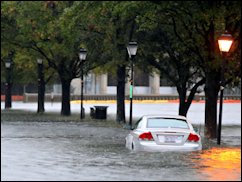by Rachel Cannon
On November 1st, 2013, President Obama signed an Executive Order “Preparing the United States for the Impacts of Climate Change” – the newest addition to the Administration’s Climate Action Plan. One part of the Executive Order establishes the Task Force on Climate Preparedness and Resilience: a collection of state, local and tribal leaders from across the country who will serve as advisors to the government on building climate preparedness and resilience in their communities.
This is a great idea – so what is the problem? Scanning the list of Task Force members reveals a glaring omission: Among all of these names, there is not a single representative from Virginia. Why not? Other east coast states, including Delaware, Maryland, and New Jersey, are represented. One state (California) has not one, not two, but three representatives on the Task Force.
Virginia, particularly coastal Virginia, needs to be a part of this.
The Task Force was created to advise, based on first-hand experiences, on how the federal government can respond to the needs of communities that are dealing with the impacts of climate change.In part, it will help agencies assist cities and towns to build “smarter and stronger,” identifying and removing barriers to investing in resilience. In other words, the Task Force will tell the government how it can help these communities prepare for and survive climate-change-fueled disasters.
Virginia, especially the Tidewater region, faces tremendous and unique threats from climate change. Moreover, communities such as Norfolk have been battling damaging weather events, not to mention storm surges and relentless flooding, for years. Virginia research institutions, such as the Virginia Institute of Marine Science (VIMS), have developed superb research on best practices and implementation. Insights from our region’s community leaders are invaluable and irreplaceable to the White House’s efforts. With no Virginians on the Task Force, who can speak on Virginia’s behalf? Maryland? Delaware? How could they? The region faces unique concerns, and must offer its correspondingly unique perspective.
Although storms and sea level rise are only some of many concerns the Administration hopes to address, they are significant, and Virginia can help. First, the predicted effects of climate change on the state are tremendous. Virginia’s Tidewater region has one of the fastest rates of sea level rise in the country. NOAA predicts there will be almost two feet of local sea level rise over the next 100 years at Chesapeake Bay Bridge Tunnel – the highest increase on the east coast. VIMS estimates that over the next 20-50 years, the Hampton Roads area could experience up to a 1.5-foot increase in sea level rise. Over 80% of the Virginia coastline is considered at “high” or “very high” risk from sea level rise. According to one estimate, 19,000 people in Norfolk and 40,000 people in Virginia Beach live below the 100-year flood level, ranking Norfolk among the five most vulnerable U.S. cities to harm from hurricanes.
Recent weather events like hurricanes have been unprecedented both in frequency and severity (consider the 4-foot storm surge in Hurricane Irene in 2011). What’s worse, the region’s land is sinking as sea level rises. The cruel trifecta of sea level rise, subsidence, and these extreme weather events, threaten to leave a much of cities like Norfolk under water. When (not if) a hurricane like Sandy touches down in Virginia, it will jeopardize homes, lives, critical infrastructure, not to mention the enormous federal investment in Naval operations. The economic and human harm in the region threatens to be astronomical.
Most importantly, Virginia is working to prepare for these forecasted harms. Leaders in Hampton Roads have expressed their desire to work with state and federal government on climate change in the region. A recent conference on adaptive planning for sea level rise in the region reached maximum capacity, with legislators, local leaders, and researchers coming together to discuss the challenges facing coastal Virginia, and how they can move forward to protect our cities and citizens.
To many, it only seems like a matter of time until Virginia’s perspective shifts from preparation to restoration, unless the region gets attention and assistance from federal resources. Entire communities are at risk, and are waiting to be heard. If the White House wants to learn from communities that are taking steps to protect themselves from extreme weather and other impacts from climate change, Virginia needs to be part of that conversation.



